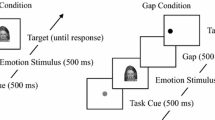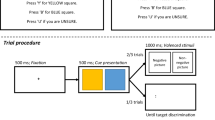Abstract
Recent studies have investigated the association between serotonin transporter gene promoter (5-HTTLPR) functional polymorphisms and attentional biases to threat, a cognitive mechanism that probably contributes to the development and maintenance of anxiety. The present study genotyped a sample of N = 141 healthy volunteers for an insertion/deletion polymorphism and the rs25531 single-nucleotide polymorphism in 5-HTTLPR. In order to investigate attentional biases to threat, we used a probe discrimination task in which the gaze direction of centrally presented fearful or neutral faces endogenously cued attention. The results indicated no significant differences in attentional biases to threat between 5-HTTLPR genotype groups. However, we found that carriers of two low-expressing alleles (i.e., S or LG) of 5-HTTLPR displayed a significant slowing of responses across trials with fearful compared to neutral faces. This effect may indicate that fearful faces triggered increased emotional arousal in these genotypes, which may have interfered with the processing of gaze direction and spatial cuing. These results suggest that using fearful faces as endogenous spatial cues may be problematic in genotypes associated with facilitated emotional arousal to these stimuli, and underscore the hypothesis that 5-HTTLPR specifically influences automatic rather than consciously-controlled processes of attention.
Similar content being viewed by others
References
Clark D. A., Beck A. T., Cognitive theory and therapy of anxiety and depression: convergence with neurobiological findings, Trends Cogn. Sci., 2010, 14, 418–424
Clark D. M., Wells A., A cognitive model of social phobia, In: Heimberg R. G., Liebowitz M. R., Hope D. A., Schneier F. R. (eds.), Social Phobia: Diagnosis, assessment and treatment, New York: Guilford Press, 1995, 69–93
Hofmann S. G., Cognitive factors that maintain social anxiety disorder: a comprehensive model and its treatment implications, Cogn. Behav. Ther., 2007, 36, 193–209
Mathews A., MacLeod C., Cognitive vulnerability to emotional disorders, Annu. Rev. Clin. Psychol., 2005, 1, 167–195
Miu A. C., Visu-Petra L., Anxiety disorders in children and adults: A cognitive, neurophysiological and genetic characterization, In: Carlstedt R. (ed.), Handbook of Integrative Clinical Psychology, Psychiatry and Behavioral Medicine: Perspectives, Practices and Research, New York: Springer, 2010, 309–352
Beck A. T., Emery G., Greenberg R. C., Anxiety disorders and phobias: A cognitive perspective, New York: Basic Books, 1985
Rapee R. M., Heimberg R. G., A cognitive-behavioral model of anxiety in social phobia, Behav. Res. Ther., 1997, 35, 741–756
MacLeod C., Mathews A., Tata P., Attentional bias in emotional disorders, J. Abnorm. Psychol., 1986, 95, 15–20
Asmundson G. J., Stein M. B., Selective processing of social threat in patients with generalized social phobia: Evaluation using a dotprobe paradigm, J. Anxiety Disord., 1994, 8, 107–117
Mogg K., Philippot P., Bradley B. P., Selective attention to angry faces in clinical social phobia, J. Abnorm. Psychol., 2004, 113, 160–165
Pishyar R., Harris L. M., Menzies R. G., Attentional bias for words and faces in social anxiety, Anxiety Stress Copin., 2004, 17, 23–36
Pishyar R., Harris L. M., Menzies R. G., Responsiveness of measures of attentional bias to clinical change in social phobia, Cognition Emotion, 2008, 22, 1209–1227
Mogg K., Bradley B. P., Millar N., White J., A follow-up study of cognitive bias in generalized anxiety disorder, Behav. Res. Ther., 1995, 33, 927–935
Lundh L. G., Ost L.-G., Attentional bias, self-consciousness and perfectionism in social phobia before and after cognitive-behaviour therapy, Scand. J. Behav. Ther., 2001, 30, 4–16
Kendler K. S., Neale M. C., Kessler R. C., Heath A. C., Eaves L. J., The genetic epidemiology of phobias in women. The interrelationship of agoraphobia, social phobia, situational phobia, and simple phobia, Arch. Gen. Psychiatry, 1992, 49, 273–281
Kendler K. S., Myers J., Prescott C. A., Neale M. C., The genetic epidemiology of irrational fears and phobias in men, Arch. Gen. Psychiatry, 2001, 58, 257–265
Hermans E. J., van Honk J., Toward a framework for defective emotion processing in social phobia, Cogn. Neuropsychiatry, 2006, 11, 307–331
Caspi A., Hariri A. R., Holmes A., Uher R., Moffitt T. E., Genetic sensitivity to the environment: the case of the serotonin transporter gene and its implications for studying complex diseases and traits, Am. J. Psychiatry, 2010, 167, 509–527
van der Linden G. J., Stein D. J., van Balkom A. J., The efficacy of the selective serotonin reuptake inhibitors for social anxiety disorder (social phobia): a meta-analysis of randomized controlled trials, Int. Clin. Psychopharmacol., 2000, 15(Suppl. 2), S15–23
Argyropoulos S. V., Hood S. D., Adrover M., Bell C. J., Rich A. S., Nash J. R., et al., Tryptophan depletion reverses the therapeutic effect of selective serotonin reuptake inhibitors in social anxiety disorder, Biol. Psychiatry, 2004, 56, 503–509
Lesch K. P., Bengel D., Heils A., Sabol S. Z., Greenberg B. D., Petri S., et al., Association of anxiety-related traits with a polymorphism in the serotonin transporter gene regulatory region, Science, 1996, 274, 1527–1531
Hu X. Z., Lipsky R. H., Zhu G., Akhtar L. A., Taubman J., Greenberg B. D., et al., Serotonin transporter promoter gain-of-function genotypes are linked to obsessive-compulsive disorder, Am. J. Hum. Genet., 2006, 78, 815–826
Wendland J. R., Martin B. J., Kruse M. R., Lesch K. P., Murphy D. L., Simultaneous genotyping of four functional loci of human SLC6A4, with a reappraisal of 5-HTTLPR and rs25531, Mol. Psychiatry, 2006, 11, 224–226
Little K. Y., McLaughlin D. P., Zhang L., Livermore C. S., Dalack G. W., McFinton P. R., et al., Cocaine, ethanol, and genotype effects on human midbrain serotonin transporter binding sites and mRNA levels, Am. J. Psychiatry, 1998, 155, 207–213
Reimold M., Smolka M. N., Schumann G., Zimmer A., Wrase J., Mann K., et al., Midbrain serotonin transporter binding potential measured with [11C]DASB is affected by serotonin transporter genotype, J. Neural. Transm., 2007, 114, 635–639
Beevers C. G., Gibb B. E., McGeary J. E., Miller I. W., Serotonin transporter genetic variation and biased attention for emotional word stimuli among psychiatric inpatients, J. Abnorm. Psychol., 2007, 116, 208–212
Perez-Edgar K., Bar-Haim Y., McDermott J. M., Gorodetsky E., Hodgkinson C. A., Goldman D., et al., Variations in the serotonintransporter gene are associated with attention bias patterns to positive and negative emotion faces, Biol. Psychol., 2010, 83, 269–271
Kwang T., Wells T. T., McGeary J. E., Swann W. B. Jr., Beevers C. G., Association of the serotonin transporter promoter region polymorphism with biased attention for negative word stimuli, Depress. Anxiety, 2010, 27, 746–751
Osinsky R., Lösch A., Hennig J., Alexander N., Macleod C., Attentional bias to negative information and 5-HTTLPR genotype interactively predict students’ emotional reactivity to first university semester, Emotion, 2012, [Epub ahead of print]
Fox E., Ridgewell A., Ashwin C., Looking on the bright side: biased attention and the human serotonin transporter gene, Proc. Biol. Sci., 2009, 276, 1747–1751
Pergamin-Hight L., Bakermans-Kranenburg M. J., van Ijzendoorn M. H., Bar-Haim Y., Variations in the promoter region of the serotonin transporter gene and biased attention for emotional information: a meta-analysis, Biol. Psychiatry, 2012, 71, 373–379
Lonsdorf T. B., Weike A. I., Nikamo P., Schalling M., Hamm A. O., Ohman, A., Genetic gating of human fear learning and extinction: possible implications for gene-environment interaction in anxiety disorder, Psychol. Sci., 2009, 20, 198–206
Miu A. C., Crisan L. G., Chis A., Ungureanu L., Druga B., Vulturar R., Somatic markers mediate the effect of serotonin transporter gene polymorphisms on Iowa Gambling Task, Genes Brain Behav., 2012, doi: 10.1111/j.1601-183X.2012.00774.x. [Epub ahead of print]
Mathews A., Fox E., Yiend J., Calder A., The face of fear: Effects of eye gaze and emotion on visual attention, Vis. Cogn., 2003, 10, 823–835
Miu A. C., Pana S. E., Avram J., Emotional face processing in neurotypicals with autistic traits: Implications for the broad autism phenotype, Psychiatry Res., 2012, [Epub ahead of print]
Ekman P., Friesen W., Pictures of facial affect, Palo Alto, CA: Consulting Psychologists Press, 1976
Rodriguez S., Gaunt T. R., Day I. N., Hardy-Weinberg equilibrium testing of biological ascertainment for Mendelian randomization studies, Am. J. Epidemiol., 2009, 169, 505–514
Posner M. I., Orienting of attention, Q. J. Exp. Psychol., 1980, 32, 3–25
Beevers C. G., Wells T. T., Ellis A. J., McGeary J. E., Association of the serotonin transporter gene promoter region (5-HTTLPR) polymorphism with biased attention for emotional stimuli, J. Abnorm. Psychol., 2009, 118, 670–681
Hariri A. R., Mattay V. S., Tessitore A., Kolachana B., Fera F., Goldman D., et al., Serotonin transporter genetic variation and the response of the human amygdala, Science, 2002, 297, 400–403
Munafo M. R., Brown S. M., Hariri A. R., Serotonin transporter (5-HTTLPR) genotype and amygdala activation: a meta-analysis, Biol. Psychiatry, 2008, 63, 852–857
Erdfelder E., Faul F., Buchner A., GPOWER: A general power analysis program. Behav. Res. Meth. Ins. C., 1996, 28, 1–11
Vulturar R., Chis A., Ungureanu L., Miu A. C., Respiratory sinus arrhythmia and serotonin transporter promoter gene polymorphisms: Genotyping the rs25531 single-nucleotide polymorphism makes a difference, Psychophysiology, 2012, under revision
Butler E. A., Wilhelm F. H., Gross J. J., Respiratory sinus arrhythmia, emotion, and emotion regulation during social interaction, Psychophysiology, 2006, 43, 612–622
Miu A. C., Heilman R. M., Miclea M., Reduced heart rate variability and vagal tone in anxiety: trait versus state, and the effects of autogenic training, Auton. Neurosci., 2009, 145, 99–103
Porges S. W., Doussard-Roosevelt J. A., Maiti A. K., Vagal tone and the physiological regulation of emotion, Monogr. Soc. Res. Child Dev., 1994, 59, 167–186
Thayer J. F., Friedman B. H., Borkovec T. D., Autonomic characteristics of generalized anxiety disorder and worry, Biol. Psychiatry, 1996, 39, 255–266
Author information
Authors and Affiliations
Corresponding author
About this article
Cite this article
Miu, A.C., Vulturar, R., Chiş, A. et al. Attentional biases to threat and serotonin transporter gene promoter (5-HTLPR) polymorphisms: Evidence from a probe discrimination task with endogenous cues. Translat.Neurosci. 3, 160–166 (2012). https://doi.org/10.2478/s13380-012-0021-1
Received:
Accepted:
Published:
Issue Date:
DOI: https://doi.org/10.2478/s13380-012-0021-1




